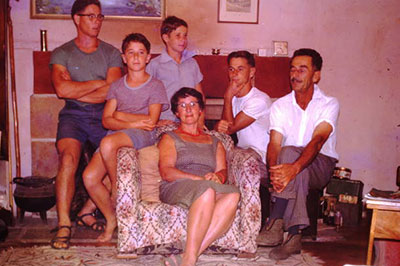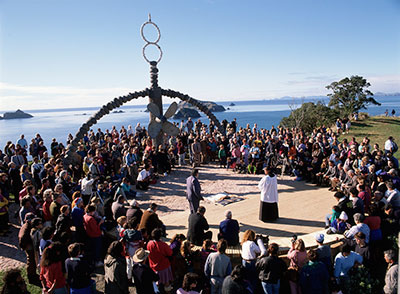 The Booth family have resided in the Bay of Islands for a long time...and there are quite a few of them. This band of brothers has an important thing in common: in their own way, they are all change agents, with a keen eye on the preservation of Aotearoa’s – and especially Peiwhairangi’s - native and natural beauty. Not content to accept the status quo (read: slow decline) in our environment, each has played their part in local ecological restoration – both the doing part of it as well as the tricky job of raising awareness in the community. (News: May/June 2015)
The Booth family have resided in the Bay of Islands for a long time...and there are quite a few of them. This band of brothers has an important thing in common: in their own way, they are all change agents, with a keen eye on the preservation of Aotearoa’s – and especially Peiwhairangi’s - native and natural beauty. Not content to accept the status quo (read: slow decline) in our environment, each has played their part in local ecological restoration – both the doing part of it as well as the tricky job of raising awareness in the community. (News: May/June 2015)

As Acting Chair and resident of the Eastern Bay of Islands, John Booth is tangled up in Fish Forever’s every step (whether he likes it or not!). The team has benefitted from his experience and guidance since the inception of the campaign. In fact, he is one of the founders. Much of his professional life saw him engaged in research (mainly on rock lobsters, which resulted in a 2011 book about them) for the then Ministry of Fisheries and NIWA that supported exploitation of native species – a career somewhat at odds with what he is doing now. At this time, ecological science was the new kid on the block and was “reactive rather than predictive or proactive. For example, the loss of shallow-reef kelp to kina through overharvesting of kina’s key predators was not foreseen.”
The world woke up to the implications of overharvesting and ecosystem destruction by the 1990s and the New Zealand Biodiversity Strategy (2000) was born: “It was our commitment to do our bit – just for the sake of it, but also because human wellbeing, even survival, depends on healthy, naturally functioning ecosystems”.
This perspective was at the forefront of John’s mind as he retired to Rawhiti, and it has informed his ‘retirement’ work program since: he became involved in local mainland pest control to reduce chances of re-invasion of the pest-free islands of Ipipiri – this group was to become a fully blown local native biodiversity protection and restoration project, Te Tangi o te Ata. John now works with Living Waters on the reduction of flow of silt and nutrients into the Bay of Islands as well as with Fish Forever, with its focus on establishing marine reserves.A productive sort of retirement, you have to agree.
 John’s twin brother Chris Booth is best known to many politically conscious and/or environmentally-minded people for the Rainbow Warrior Memorial (1988-90). While he has been active in conservation and preservation work for most of his life (45 years ago, in 1970, he was battling alongside his brother Robin and mother Joyce for the preservation of the Kerikeri Stone Store area and has participated in a legion of actions and marches challenging and highlighting threats to our environment) Chris agrees that the most meaningful impact in this arena has been through his creativity as a sculptor. His 1973 work, the Manuka Spiral, was created to acknowledge the huge effort locals made to save the Kerikeri Stone Store area. Sadly it was never built full scale on site.
John’s twin brother Chris Booth is best known to many politically conscious and/or environmentally-minded people for the Rainbow Warrior Memorial (1988-90). While he has been active in conservation and preservation work for most of his life (45 years ago, in 1970, he was battling alongside his brother Robin and mother Joyce for the preservation of the Kerikeri Stone Store area and has participated in a legion of actions and marches challenging and highlighting threats to our environment) Chris agrees that the most meaningful impact in this arena has been through his creativity as a sculptor. His 1973 work, the Manuka Spiral, was created to acknowledge the huge effort locals made to save the Kerikeri Stone Store area. Sadly it was never built full scale on site.
Of his current work, Chris says: “I’m working closely with Te Runanga o Ngati Rehia to raise funds to build an entranceway sculpture at Bulls Gorge called Te Haa o te Ao (Breath of the World) which will move reflecting how much our district is doing to combat climate change. Schools will do the monitoring, covering all aspects - from the health of our seas, our land to our atmosphere.” Chris has nutured a similar sense of concern for our environment in his family. Our May/June newsletter features the work of his daughter, Lena Huia (12), who conceived and carried out her own monitoring project in Whapukapirau Bay in the summer of 2015.
Like John, Webber Booth has been very much hands on in his conservation work. “In 2011 elders of Ngati Torehina, kaitiaki of Harakeke, welcomed my offer to control pests on Harakeke Island. I was going fishing anyway.” This 12-hectare island landward of Tikitiki (Nine Pin) has coastal forest matched in quality only by Motukokako in the Bay of Islands, with a substantial population of grey-faced petrels. Since efforts by DoC to run a pest control program lapsed in the 1990s, the rat population exploded: “a varied diet of fruit and seeds, a wide range of invertebrates and seabird eggs and chicks spelt doom for this unique coastal ecosystem.”  With support and advice from DoC Kerikeri and volunteers, Webber and team set up 50 bait stations together with tracking tunnels, snap traps and stoat traps. Intensive poisoning in the first year reduced rat numbers so that they could be managed with baited snap traps. Poisoned rats secondarily killed some stoats while others were caught in egg-baited traps. “Between Harakeke and Mataka mainland there are two stepping stone islands separated by the turbulent Wiwiki passage. This waterway is only a moderate hindrance to rats and stoats. A fortress of traps on these islands is intended to stop intruders reaching the now pristine Harakeke Island.”
With support and advice from DoC Kerikeri and volunteers, Webber and team set up 50 bait stations together with tracking tunnels, snap traps and stoat traps. Intensive poisoning in the first year reduced rat numbers so that they could be managed with baited snap traps. Poisoned rats secondarily killed some stoats while others were caught in egg-baited traps. “Between Harakeke and Mataka mainland there are two stepping stone islands separated by the turbulent Wiwiki passage. This waterway is only a moderate hindrance to rats and stoats. A fortress of traps on these islands is intended to stop intruders reaching the now pristine Harakeke Island.”
In Jan 2015 DOC personnel together with two rat dogs and one stoat dog pronounced Harakeke clear of these pests. To maintain this status monthly or ideally bimonthly visits are required. “It's not always a piece of cake - it's a near vertical rock landing. I've fallen in a couple of times - but that's all part of the fun.”
